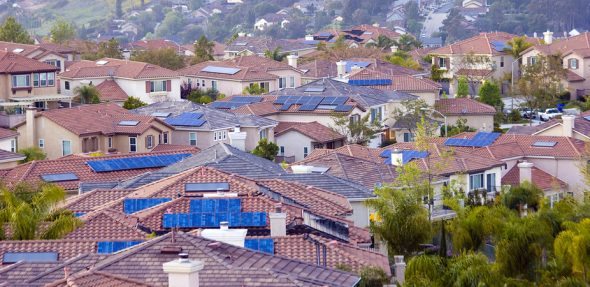A new study by the Pecan Street Research Institute found that residential solar panel systems can cut electricity demand during peak summer hours by 58 percent.
The study used data gathered from Pecan Street’s demonstration project — an innovative living test lab that allows the research institute to provide original research on customer energy use, renewable energy integration and smart grid technology.
By monitoring 50 single-family homes in Austin, Texas with west- and/or south-facing solar panels from June through August this year, the study found that west-facing solar panels produced 49 percent more electricity during summer peak demand hours than south-facing panels, a finding that should make utilities think twice about excluding west-facing solar panel systems from solar rebate programs. According to the study, west-facing rooftop systems cut peak demand 65 percent, while south-facing systems reduced peak demand 54 percent.
Though west-facing systems may be better at cutting summer peak demand and add more value to the grid in certain regions, south-facing systems still have an advantage in total annual energy production — an important distinction mentioned in the report.
The Pecan Street study also looked at how much solar power was being used in the homes versus being returned to the grid. It found that during peak hours, homes used 80 percent of the solar power generated on-site, while just 20 percent was sent back to the grid. Over the course of a full day, 64 percent of the solar power generated on-site was used in the home.
Overall, the study concluded that solar panel systems can be an effective peak demand reduction tool, especially during hot summer months when utilities are trying to keep up with energy consumption.
“These findings suggest that rooftop solar systems can produce large summer peak reductions that benefit utilities and customers alike without requiring customers to change their behavior or sacrifice comfort,” said Pecan Street CEO Brewster McCracken in the report’s press release.
The Pecan Street study makes it clear that utilities have a lot to gain from rooftop solar, which isn’t the prevailing sentiment coming from the utility sector lately. Just last month, Arizona Public Service, the largest utility in Arizona, admitted that it had funded anti-solar ads during its campaign to change the state’s net metering policy.
During peak energy demand in the summer, the cost to provide electricity is extremely high and often unprofitable. By cutting summer peak demand more than 50 percent, solar panel systems offer benefits to the grid that could reduce costs for both utilities and their customers.
Mari Hernandez is a Research Associate on the Energy team at the Center for American Progress.
This article was originally published on by Climate Progress. Reproduced with permission










